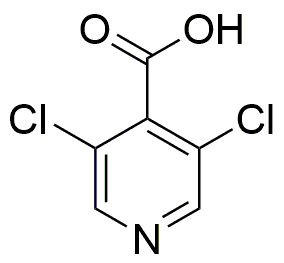3,5-Dichloroisonicotinic acid is widely utilized in research focused on:
- Pesticide Development: This compound serves as a key intermediate in synthesizing novel agrochemicals, helping to create more effective and environmentally friendly pesticides.
- Pharmaceutical Research: It is used in the development of new pharmaceuticals, particularly in creating compounds that target specific biological pathways, enhancing drug efficacy.
- Material Science: The compound is involved in the synthesis of advanced materials, including polymers and coatings, which offer improved durability and resistance to environmental factors.
- Biochemical Studies: Researchers utilize it to study the interactions of chlorinated compounds with biological systems, providing insights into their mechanisms of action and potential therapeutic uses.
- Analytical Chemistry: It serves as a standard reference material in analytical methods, aiding in the accurate quantification of similar compounds in various samples.
Informations générales
Propriétés
Sécurité et réglementation
Applications
3,5-Dichloroisonicotinic acid is widely utilized in research focused on:
- Pesticide Development: This compound serves as a key intermediate in synthesizing novel agrochemicals, helping to create more effective and environmentally friendly pesticides.
- Pharmaceutical Research: It is used in the development of new pharmaceuticals, particularly in creating compounds that target specific biological pathways, enhancing drug efficacy.
- Material Science: The compound is involved in the synthesis of advanced materials, including polymers and coatings, which offer improved durability and resistance to environmental factors.
- Biochemical Studies: Researchers utilize it to study the interactions of chlorinated compounds with biological systems, providing insights into their mechanisms of action and potential therapeutic uses.
- Analytical Chemistry: It serves as a standard reference material in analytical methods, aiding in the accurate quantification of similar compounds in various samples.
Documents
Fiches de données de sécurité (FDS)
La FDS fournit des informations de sécurité complètes sur la manipulation, le stockage et l’élimination du produit.
Spécifications du produit (PS)
Le PS fournit une description complète des propriétés du produit, notamment sa composition chimique, son état physique, sa pureté et les exigences de stockage. Il détaille également les plages de qualité acceptables et les applications prévues du produit.
Certificats d'analyse (COA)
Recherchez des certificats d'analyse (COA) en saisissant le numéro de lot du produit. Les numéros de lot et de lot se trouvent sur l'étiquette d'un produit, après les mots « Lot » ou « Lot de fabrication ».
Numéro de catalogue
Numéro de lot/série
Certificats d'origine (COO)
Ce certificat d'exploitation confirme le pays dans lequel le produit a été fabriqué, et détaille également les matériaux et composants utilisés et s'il est issu de sources naturelles, synthétiques ou autres sources spécifiques. Ce certificat peut être requis pour les douanes, le commerce et la conformité réglementaire.
Numéro de catalogue
Numéro de lot/série
Fiches de données de sécurité (FDS)
La FDS fournit des informations de sécurité complètes sur la manipulation, le stockage et l’élimination du produit.
DownloadSpécifications du produit (PS)
Le PS fournit une description complète des propriétés du produit, notamment sa composition chimique, son état physique, sa pureté et les exigences de stockage. Il détaille également les plages de qualité acceptables et les applications prévues du produit.
DownloadCertificats d'analyse (COA)
Recherchez des certificats d'analyse (COA) en saisissant le numéro de lot du produit. Les numéros de lot et de lot se trouvent sur l'étiquette d'un produit, après les mots « Lot » ou « Lot de fabrication ».
Numéro de catalogue
Numéro de lot/série
Certificats d'origine (COO)
Ce certificat d'exploitation confirme le pays dans lequel le produit a été fabriqué, et détaille également les matériaux et composants utilisés et s'il est issu de sources naturelles, synthétiques ou autres sources spécifiques. Ce certificat peut être requis pour les douanes, le commerce et la conformité réglementaire.


